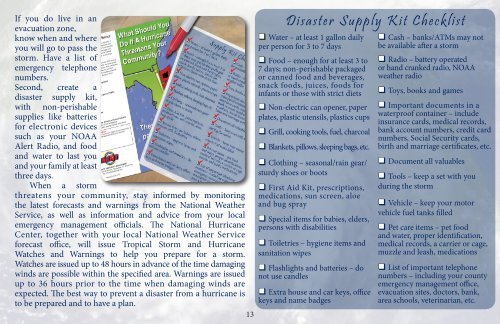2015 Guide
2015 Guide
2015 Guide
You also want an ePaper? Increase the reach of your titles
YUMPU automatically turns print PDFs into web optimized ePapers that Google loves.
If you do live in an<br />
evacuation zone,<br />
know when and where<br />
you will go to pass the<br />
storm. Have a list of<br />
emergency telephone<br />
numbers.<br />
Second, create a<br />
disaster supply kit,<br />
with non-perishable<br />
supplies like batteries<br />
for electronic devices<br />
such as your NOAA<br />
Alert Radio, and food<br />
and water to last you<br />
and your family at least<br />
three days.<br />
When a storm<br />
threatens your community, stay informed by monitoring<br />
the latest forecasts and warnings from the National Weather<br />
Service, as well as information and advice from your local<br />
emergency management officials. The National Hurricane<br />
Center, together with your local National Weather Service<br />
forecast office, will issue Tropical Storm and Hurricane<br />
Watches and Warnings to help you prepare for a storm.<br />
Watches are issued up to 48 hours in advance of the time damaging<br />
winds are possible within the specified area. Warnings are issued<br />
up to 36 hours prior to the time when damaging winds are<br />
expected. The best way to prevent a disaster from a hurricane is<br />
to be prepared and to have a plan.<br />
13<br />
Disaster Supply Kit Checklist<br />
q Water – at least 1 gallon daily<br />
per person for 3 to 7 days<br />
q Food – enough for at least 3 to<br />
7 days; non-perishable packaged<br />
or canned food and beverages,<br />
snack foods, juices, foods for<br />
infants or those with strict diets<br />
q Non-electric can opener, paper<br />
plates, plastic utensils, plastics cups<br />
q Grill, cooking tools, fuel, charcoal<br />
q Blankets, pillows, sleeping bags, etc.<br />
q Clothing – seasonal/rain gear/<br />
sturdy shoes or boots<br />
q First Aid Kit, prescriptions,<br />
medications, sun screen, aloe<br />
and bug spray<br />
q Special items for babies, elders,<br />
persons with disabilities<br />
q Toiletries – hygiene items and<br />
sanitation wipes<br />
q Flashlights and batteries – do<br />
not use candles<br />
q Extra house and car keys, office<br />
keys and name badges<br />
q Cash – banks/ATMs may not<br />
be available after a storm<br />
q Radio – battery operated<br />
or hand cranked radio, NOAA<br />
weather radio<br />
q Toys, books and games<br />
q Important documents in a<br />
waterproof container – include<br />
insurance cards, medical records,<br />
bank account numbers, credit card<br />
numbers, Social Security cards,<br />
birth and marriage certificates, etc.<br />
q Document all valuables<br />
q Tools – keep a set with you<br />
during the storm<br />
q Vehicle – keep your motor<br />
vehicle fuel tanks filled<br />
q Pet care items – pet food<br />
and water, proper identification,<br />
medical records, a carrier or cage,<br />
muzzle and leash, medications<br />
q List of important telephone<br />
numbers – including your county<br />
emergency management office,<br />
evacuation sites, doctors, bank,<br />
area schools, veterinarian, etc.


